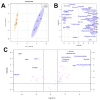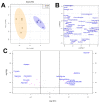Biochemical Response to Freezing in the Siberian Salamander Salamandrella keyserlingii
- PMID: 34827165
- PMCID: PMC8614755
- DOI: 10.3390/biology10111172
Biochemical Response to Freezing in the Siberian Salamander Salamandrella keyserlingii
Abstract
The Siberian salamander Salamandrella keyserlingii Dybowski, 1870 is a unique amphibian that is capable to survive long-term freezing at -55 °C. Nothing is known on the biochemical basis of this remarkable freezing tolerance, except for the fact that it uses glycerol as a low molecular weight cryoprotectant. We used 1H-NMR analysis to study quantitative changes of multiple metabolites in liver and hindlimb muscle of S. keyserlingii in response to freezing. For the majority of molecules we observed significant changes in concentrations. Glycerol content in frozen organs was as high as 2% w/w, which confirms its role as a cryoprotectant. No other putative cryoprotectants were detected. Freezing resulted in ischemia manifested as increased concentrations of glycolysis products: lactate and alanine. Unexpectedly, we detected no increase in concentrations of succinate, which accumulates under ischemia in various tetrapods. Freezing proved to be a dramatic stress with reduced adenosine phosphate pool and high levels of nucleotide degradation products (hypoxanthine, β-alanine, and β-aminoisobutyrate). There was also significant increase in the concentrations of choline and glycerophosphocholine, which may be interpreted as the degradation of biomembranes. Thus, we found that freezing results not only in macroscopical damage due to ice formation, but also to degradation of DNA and biomembranes.
Keywords: Salamandrella keyserlingii; Siberian salamander; cryoprotectants; freeze tolerance; freezing; glycolysis.
Conflict of interest statement
The authors declare no conflict of interest.
Figures






References
Grants and funding
LinkOut - more resources
Full Text Sources

